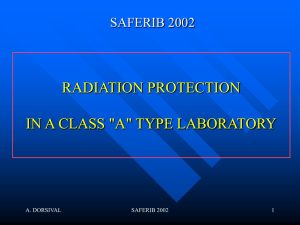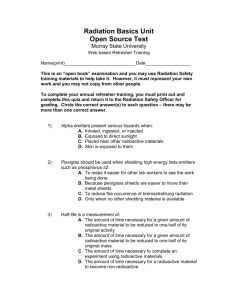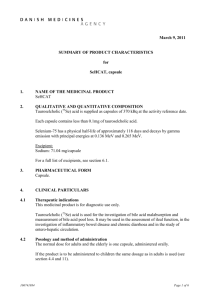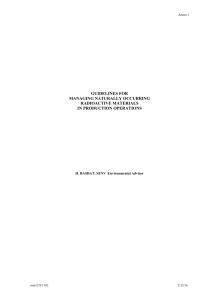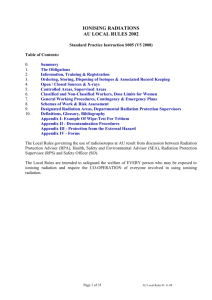Information Required in Support of the Research Use of A Non
advertisement
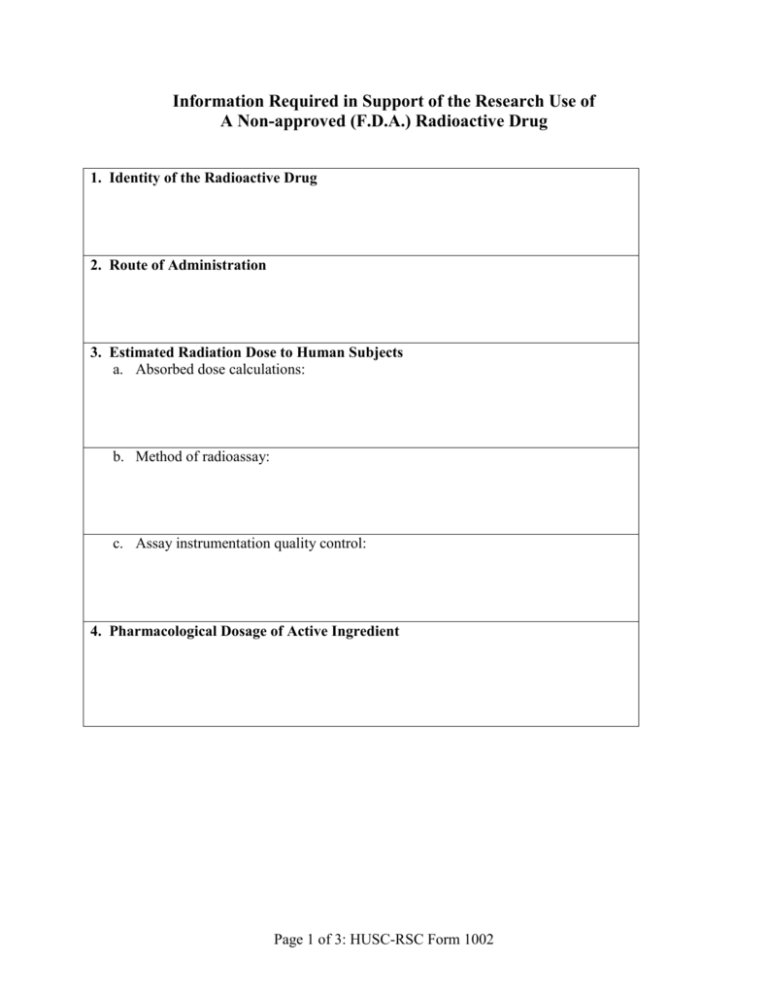
Information Required in Support of the Research Use of A Non-approved (F.D.A.) Radioactive Drug 1. Identity of the Radioactive Drug 2. Route of Administration 3. Estimated Radiation Dose to Human Subjects a. Absorbed dose calculations: b. Method of radioassay: c. Assay instrumentation quality control: 4. Pharmacological Dosage of Active Ingredient Page 1 of 3: HUSC-RSC Form 1002 Information Required in Support of the Research Use of A Non-approved (F.D.A.) Radioactive Drug (Continued) 5. Quality of the Radioactive Drug a. Method of preparation/dispensing: b. Minimum acceptance criteria: Visual appearance: PH: Radiochemical purity: Chemical purity: Specific activity: Radionuclide purity or identification: Pyrogens or bacterial endotoxins (parenterals only): Sterility (parenterals only): c. Preclinical validation studies: Page 2 of 3: HUSC-RSC Form 1002 Information Required in Support of the Research Use of A Non-approved (F.D.A.) Radioactive Drug (Continued) 5. Quality of the Radioactive Drug (continued): d. Routine quality control procedures: Visual appearance: pH: Radiochemical purity: Chemical purity: Specific activity: Radionuclide purity or identification: Pyrogens or bacterial endotoxins (parenterals only): Sterility (parenterals only): e. Expiration dating: 6. Labeling of the radioactive drug I certify that the above information is correct: ________________________________ Principle Investigator Signature/Date ______________________________ Authorized User Signature/Date Page 3 of 3: HUSC-RSC Form 1002 Special Conditions for the Research Use of a Radioactive Drug That Is Not F.D.A. Approved (21 CFR Part 361.1) 1. Definition of “research use” Radioactive drugs are generally recognized as safe and effective when administered to human research subjects during the course of a research project intended to obtain basic information regarding the kinetics (including distribution and localization) and metabolism of the radioactive drug or regarding human physiology, pathophysiology, or biochemistry; but not when intended for immediate diagnostic, therapeutic, or similar purposes or to determine the safety and effectiveness of the drug in humans for such purpose (i.e., to carry out a clinical trial). 2. Human research subjects Research subjects shall be at least 18 years of age and legally competent. Exceptions are permitted only in those special situations when it can be demonstrated that the study presents a unique opportunity to gain information not currently available, and that the study requires the use of research subjects less than 18 years of age. The number of subjects included in the research study shall be sufficient but no greater than necessary to achieve the objective(s) of the study (i.e., to obtain basic research information). Inclusion of more than 30 subjects or subjects less than 18 years of age in the research study requires advanced notification of the F.D.A. and must be scientifically rationalized. 3. Limit on radiation dose The amount of the radioactive drug administered shall be such that the subject receives the smallest radiation dose with which it is practical to perform the study without jeopardizing the benefits to be obtained from the study. Under no circumstances may the radiation dose to an adult research subject from a single study exceed 3 rems to the whole body, active blood-forming organs, lens of the eye, or gonads; or 5 rems in a single study to any other organ. (A “single study” is defined as all procedures performed on a subject during a single study session.) The total dose commitment from multiple studies (by all investigators) performed on the same subject within 1 year may not exceed 5 rems to the whole body, active blood-forming organs, lens of the eye, or gonads; or 15 rems to any other organ. Radiation doses from x-ray or other procedures that are part of the research study (i.e., would not have occurred but for the research study) shall be included when determining the single study radiation absorbed doses and total dose commitments. For a research subject under 18 years of age at his/her last birthday, the radiation dose shall not exceed 10% of the limits described above. Numerical definitions of the radiation dose shall be based on an absorbed fraction method of calculation such as the system set forth by the Medical Internal Radiation Dose Committee (MIRD) of the Society of Nuclear Medicine or the International Commission on Radiological Protection (ICRP). HUSC-RSC 1002

